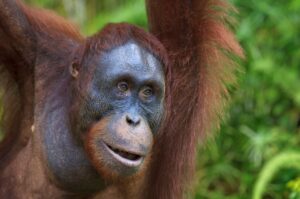The Ordovician world was a watery one in which vast oceans covered almost the entire northern hemisphere. In the south, the mega-continent of Gondwana drifted. According to the University of California-Berkeley, shallow seas varyingly lapped at its shores and swamped its inland areas. This all happened around 470 million years ago.
Now, two hobby paleontologists have dug up a mother lode of fossilized remains from that ancient lowland.
Eric Monceret and Sylvie Monceret-Goujon found one of the world’s richest and most biodiverse fossil sites from the Lower Ordovician period (488-444 million years ago) in southern France. Located in Montagne Noire near the Spanish border, the deposit contains over 400 fossils. Many include extremely rare soft tissue remnants.

a) Trilobite. b) Gastropods. c) Cnidarian, a group that includes jellyfish and sea anemones. d) Articulated brachiopods attached to a possible sponge. e) Assemblage of articulated brachiopods (center), flattened carapaces probably of bivalved arthropods (center left and right), and a trilobite. f) A hyolith with possible internal organs. Scale bars represent 4 mm in a and e, 1 cm in b and d, 5 mm in c, and 2 mm in f. Photo: Saleh et al
Hundreds of millions of years of continental drift placed the site in the two amateurs’ purview. A study detailing the yield appeared recently in the journal Nature Ecology & Evolution.
Game changer
It’s hard to overstate the significance of the find. While the Cambrian explosion 70 million years earlier has yielded hundreds of soft-tissue fossils, only 30 Ordovician fossils with soft tissue had previously been found.
The deposit, called the Cabrières Biota, contains fossilized body parts from shell-like structures to digestive systems and even cuticles. They come from arthropods — the group of animals including insects, spiders, scorpions, shrimp, cnidarians (jellyfish and corals), plus algae and sponges.
What were they doing there? Likely escaping extreme heat. Water temperatures in tropical Ordovician oceans soared to 47˚C. Researchers think these conditions played a key role in the Cabrières Biota’s biodiversity.

Tropical temperatures soared in the Ordovician period. Photo: Creative Commons
“The high-latitude Cabrières Biota would have experienced less extreme temperatures…fostering the development of a unique diversity,” the paper reads.
Most sites like it worldwide exhibit a general uniformity of sponges and algae. But in the Cabrières Biota, you’ll find brachiopods, trilobites, bivalved arthropods, worms, cnidarians, and mollusks.
The fossilized loot has landed in the hands of scientists at the Faculty of Geosciences and Environment at the University of Lausanne. Here, international teams will conduct the final analysis.
Monceret-Goujon and Monceret, the fossil hunters who found the deposit, commented on the event to Cosmos Magazine.
“We’ve been prospecting and searching for fossils since the age of twenty,” said Monceret.
“When we came across this amazing biota, we understood the importance of the discovery and went from amazement to excitement,” Monceret-Goujon added.






